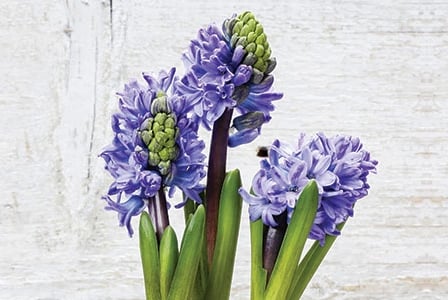
To alleviate the gloom and chill of autumn, consider forcing spring flowering bulbs into bloom.
Let’s face it: our long Canadian winters can sometimes dampen the spirits. To ease away the gloom and chill, why not consider forcing spring flowering bulbs into bloom? The bright colours and promise of a new season will elevate your mood, or make a lovely gift for that special someone.
What is forcing?
Making a plant bloom at an unnatural time and in artificial conditions is referred to as forcing. Daffodils and crocuses planted in the garden will not flower until the snow has melted away and the weather sufficiently warms; when you force the same plants indoors, you are creating a specialized microclimate that encourages them to bloom at a time you desire.
The following bulbs and corms are easy to force indoors and can add a sparkle to your winter décor in addition to putting a smile on your face:
- crocuses (Crocus spp.)
- daffodils (Narcissus spp.)
- tulips (Tulipa spp.)
- hyacinths (Hyacinthus spp.)
- snowdrops (Galanthus spp.)
- grape hyacinth (Muscari spp.)
- glory-of-the-snow (Chionodoxa spp.)
- amaryllis
Planning ahead
- It’s important to note that most bulbs, with the exception of paperwhites and amaryllis, require a chilling period before they can be forced. The chilling period spurs the embryo within the bulbs to grow and form fully developed flowers.
- Plan ahead if you want your bulbs to bloom at a certain time: the chilling period (which follows planting) for most spring flowering plants generally lasts three to four months.
- Unless you grow amaryllis or paperwhites, if you want your bulbs to flower for Christmas, you will need to begin chilling them no later than September.
Selecting bulbs
- Autumn is the best time to find a wide selection of spring flowering bulbs in the garden centre, although some mail order catalogues may carry them during the winter.
- Paperwhites and amaryllis are usually easy to obtain just before the holiday season.
- Avoid any misshapen, rotten, or shrivelled specimens.
Storing bulbs
- If you cannot plant your new bulbs right away, store them in a perforated paper bag in a cool place such as a cold storage room or refrigerator.
- Be aware of certain poisonous varieties, such as daffodils, if small children are around.
Containers for planting bulbs
- Mine your recycling bin for containers, making sure to clean them well, and add some craft details such as paint to decorate them.
- Make sure your container has sufficient holes in the bottom for drainage, as well as a saucer to catch any drips.
- Hyacinths, muscari, and crocuses may be forced in water in specialized clear glass vases.
- Paperwhites and daffodils may be grown in a shallow bowl lined with aquarium gravel, sand, or colourful glass or plastic baubles.
Planting tips
- Use a good commercial soilless mix or a potting soil mix that contains only a small amount of peat moss for planting bulbs. No fertilizer is necessary.
- Fill containers three-quarters full with soil or other media, and nestle bulbs inside.
- Plant multiple bulbs in one pot. For example, for a 6 in (15 cm) pot:
- 3 hyacinths
- 6 tulip bulbs
- 6 daffodils
- 15 crocuses
- Large bulbs such as amaryllis, tulips, and daffodils can be left with their tops exposed, as long as up to 2 in (5 cm) of soil covers the base. Others, such as crocuses, hyacinths, and snowdrops should be covered completely.
- Label pots with the variety, planting date, and the date the bulbs should be brought indoors for forcing.
- Thoroughly water the bulbs.
- Place planted bulbs in a cool location such as an unheated garage or cold storage room to chill. Your fridge may also serve as a storage space if it operates at a temperature no colder than 39 F (4 C).
- Maintain a regular watering schedule during the chilling period to avoid soil becoming dry. If you’re growing bulbs in water, ensure that the vases are topped off regularly. Refresh the water if it discolours.
Forcing bulbs to flower
- Once bulbs have finished their chilling period (if necessary), bring them into a location with indirect light to begin the forcing process.
- Once green growth emerges, the plants can be moved to a sunnier, warmer spot. Most species will usually bloom within a month.
- Water bulbs at least once a week or when necessary; do not allow them to dry out, and never overwater.
With very little effort, you and your loved ones can enjoy spring flowers in the cold dark of winter!
Giving forced bulbs as gifts
Timing is everything; it is best to give your blooms just before they fully open, so start your project early to allow for the chilling period. Amaryllis and paperwhites are especially good candidates for gifts, as they usually bloom within five weeks of planting.
- Select a style and colour of container that reflects the taste of the recipient or celebrates a festive occasion.
- Try painting the container, or wrap it in fabric ribbon or natural fibres such as jute or raffia.
- Glue or tie on accoutrements such as beads, shells, or holiday ornaments.
- Check scrapbook supply shops for inspiration, and add tags decorated with a favourite quote, poem, or even a photograph.
- Decoupage is another crafty idea: use thick paste to adhere paper or fabric scraps to your container.
- Tuck in a beautifully handwritten or typed note with care instructions, and delight in the smiles of your recipient!

